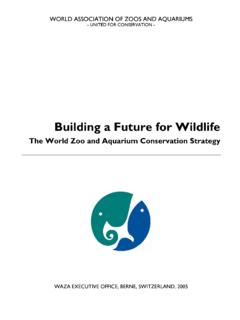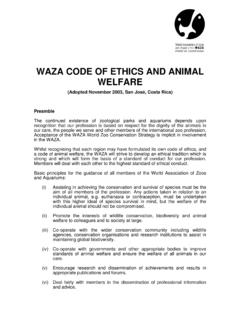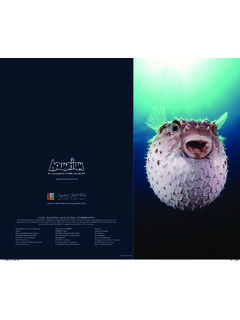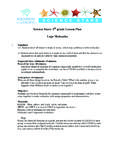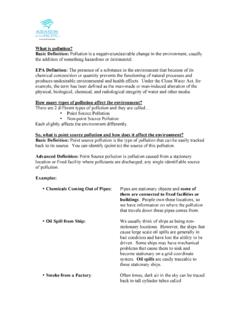Transcription of A Global Evaluation of Biodiversity Literacy in Zoo and ...
1 A Global Evaluation of Biodiversity Literacy in Zoo and aquarium VisitorsTitle: A Global Evaluation of Biodiversity Literacy in Zoo and aquarium VisitorsAuthors: Andrew Moss | Chester Zoo, Chester, UK Eric Jensen, PhD | Department of Sociology, University of Warwick, Coventry, UK Markus Gusset, PhD | World Association of Zoos and Aquariums (WAZA) Executive Office, Gland, SwitzerlandPublisher: World Association of Zoos and Aquariums (WAZA) Executive Office, Gland, SwitzerlandLayout and design: Michal Str nsk | Star M sto, Czech RepublicIllustrations: J lia Hanuliakov | Zoo Design, Inc. : 2014 World Association of Zoos and Aquariums (WAZA)Citation: Moss, A., Jensen, E. & Gusset, M. (2014) A Global Evaluation of Biodiversity Literacy in Zoo and aquarium Visitors. Gland: WAZA Executive Office, 37 ..1 Executive summary ..2 Abstract ..5 Introduction ..5 Methods ..7 Results ..13 Discussion ..31 Acknowledgements.
2 34 References ..34 Appendix ..36 WAZA Executive Office IUCN Conservation Centre Rue Mauverney 28 CH-1196 Gland Ehmke, President of WAZAZoos and aquariums have embraced the idea that one of their primary responsibilities if not their ultimate goal is to provide education to enhance awareness and understanding of Biodiversity , and to help their visitors take personal action to conserve Biodiversity . But until now, no definitive scientific study of the effectiveness of these efforts has been undertaken. In many ways, this has been a threshold existential question: are the edu-cational efforts of zoos and aquariums directed towards their millions of visitors achieving meaningful results?It is, therefore, with great interest and excitement that the results of A Global Evaluation of Biodiversity Literacy in Zoo and aquarium Visitors are presented here. This report analyses and summarises the most comprehensive zoo and aquarium visitor Biodiversity -awareness survey ever undertaken.
3 Thirty WAZA mem-ber institutions from around the world participated in a broad-based study of visitors awareness of the values of Biodiversity , their understanding of biodiver-sity, and of the steps they can take to conserve and use it sustainably. The very encouraging main finding of the study is that both Biodiversity understanding and knowledge of actions to help protect Biodiversity in survey respondents significantly increased during visits to a zoo or aquarium . This empirical evidence supports what we have long asserted and believed that zoos and aquariums can be powerful catalysts for develop-ing a conservation ethic and awareness of supportive behaviours among our huge and growing Global results of this study underscore the potential role of zoos and aquariums in achieving progress towards the goal articulated in Aichi Biodiversity Target 1 that by 2020, at the latest, people are aware of the values of Biodiversity and the steps they can take to conserve and use it sustainably.
4 Of course, far more can and must be done; but we now have a strong baseline from which to measure our progress. Efforts like WAZA s Biodiversity is Us campaign, and the many interpre-tive programmes of individual zoos and aquariums, can now be developed and implemented with the affirma-tion that they potentially can make a difference for Global Evaluation of Biodiversity Literacy in Zoo and aquarium VisitorsWAZA | 2014 Executive summaryThe findings presented below are based on the largest and most international study of zoo and aquarium visitors ever conducted worldwide. The study used a pre - and post-visit repeated -measures survey design to evaluate Biodiversity Literacy Biodiversity understanding and knowledge of actions to help protect Biodiversity in zoo and aquarium visitors. In total, more than 6,000 visitors to 30 zoos and aquariums around the globe participated in the visit Biodiversity understanding Respondents pre visit Biodiversity understanding was on a 10 point scale.
5 A score of 3 out of 10 on this scale would indicate knowing that bio-diversity is related to biological phenomena, but no evidence of any deeper understanding. Based on the scoring criteria, of respondents showed strongly positive evidence of Biodiversity understanding, while of respondents demon-strated at least some positive evidence of Biodiversity understanding. Respondents that were first time visitors showed significantly lower pre visit Biodiversity understand-ing than those that were repeat visitors to zoos and aquariums. Respondents that were a member or season ticket holder of the zoo or aquarium showed significantly higher pre-visit Biodiversity understanding than those that were not. Respondents that were a member of a nature, conser-vation or environmental group showed significantly higher pre-visit Biodiversity understanding than those that were not. Younger respondents and respondents with longer formal education showed significantly higher pre visit Biodiversity understanding, but effect sizes were in Biodiversity understanding from pre to post visit Respondents showed a significant increase in biodi-versity understanding from to between pre - and post-visit on a 10-point scale.
6 This means that, despite the positive change, respondents Biodiversity understanding was still somewhat limited after the zoo or aquarium visit. There was an increase from pre visit ( ) to post visit ( ) in respondents demonstrating at least some positive evidence of Biodiversity under-standing. Respondents from Africa and Asia showed a signifi-cantly smaller change in Biodiversity understanding between pre - and post-visit, while respondents from Europe and the Middle East showed a significantly larger change, than respondents from other world regions. Respondents that saw or heard Biodiversity informa-tion during their visit showed a significantly larger change in Biodiversity understanding between pre - and post-visit than those that had not. Respondents that were a member of a nature, conser-vation or environmental group showed a significantly smaller change in Biodiversity understanding be-tween pre - and post-visit than those that were not.
7 Older respondents and respondents with longer for-mal education showed a significantly larger change in Biodiversity understanding between pre - and post visit, but effect sizes were of zoo and aquarium visitors of respondents were women. Respondents mean age was 35 years. Respondents mean number of years spent in formal education was 15. of respondents were repeat visitors to the zoo or aquarium . of respondents had not visited any zoo or aquarium before. Respondents mean number of zoo and aquarium visits in the last 12 months was four. of respondents were local to the area of the zoo or aquarium . of respondents were a member or season ticket holder of the zoo or aquarium . of respondents had watched TV nature shows in the last 12 months. Respondents mean visiting group size was six. of respondents were a member of a nature, conservation or environmental of zoo and aquarium visits Respondents most selected categories of pre visit motivations for visiting the zoo or aquarium were: have a fun day out ( ), see animals ( ) and spend family time ( ).
8 There were substantial shifts from respondents pre-visit motivations to post-visit self-reports about their visiting experiences. Most substantially, while of respondents indicated pre-visit that they expected to learn about animals , of respondents self reported that they did learn about animals during their visit. Respondents mean time spent visiting the zoo or aquarium was 3 hours 16 minutes. of respondents saw or heard Biodiversity information during their visit. of respondents attended an animal talk or show during their visit. of respondents talked to zoo or aquarium staff or volunteers during their visit. of respondents watched a video or film during their visit. of respondents used a smartphone application during their Global Evaluation of Biodiversity Literacy in Zoo and aquarium VisitorsWAZA | 2014 Pre visit knowledge of pro Biodiversity actions Respondents pre visit knowledge of actions to help protect Biodiversity was on a 10-point scale.
9 A score of 5 out of 10 on this scale could be obtained by being able to name one pro- Biodiversity action that is not feasible to address as an individual and another specific action that could be achieved at an individual level. Based on the scoring criteria, of respondents could provide a pro- Biodiversity action that could actually be achieved at an individual level. By contrast, of respondents self-reported having undertaken their named pro- Biodiversity ac-tions within the month prior to completing the survey. This suggests that self-reports of having undertaken pro- Biodiversity actions should be treated with scep-ticism. Respondents from Central and South America showed significantly lower pre visit knowledge of pro- Biodiversity actions than respondents from other world regions. Female respondents showed significantly higher pre-visit knowledge of pro- Biodiversity actions than male respondents. Respondents that had watched TV nature shows in the last 12 months showed significantly higher pre-visit knowledge of pro- Biodiversity actions than those that had not.
10 Respondents that were a member of a nature, conser-vation or environmental group showed significantly higher pre-visit knowledge of pro- Biodiversity actions than those that were not. Younger respondents and respondents with longer formal education showed significantly higher pre visit knowledge of pro Biodiversity actions, but effect sizes were small. Respondents suggested a wide range of actions or behaviours to help protect Biodiversity . The larg-est category, in terms of number of responses, was supporting other relevant organisations (not zoos or aquariums) ( ).Change in knowledge of pro Biodiversity actions from pre to post visit Respondents showed a significant increase in knowledge of actions to help protect Biodiversity from to between pre and post-visit on a 10-point scale. There was an increase from pre visit ( ) to post visit ( ) in respondents that could identify a pro- Biodiversity action that could be achieved at an individual level.
